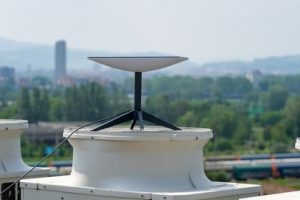Elon Musk’s Starlink device aims to bring the internet to the world’s most remote areas, and it’s off to a great start so far. The satellite-based system has been lauded by Starlink beta users currently residing in rural areas in the United States, noting that it is superior to alternatives currently available on the market. For some residents in France, however, the idea of Starlink is worth resisting.
SpaceX needs to develop a network of ground stations that link Starlink’s satellites to the physical backbone of the internet to achieve its worldwide internet connectivity objectives. Saint-Senier-de-Beuvron, a village in France situated less than 12 miles (20km) from the World Heritage Site of Mont Saint-Michel, is among the places suggested for such a station. Although there are only around 350 people living in the town, they have spoken out against the Starlink platform.
Francois Dufour, a retired farmer and member of the Greens Council, argued in a statement to Agence France-Presse (AFP) that the facility could present risks to residents in the region. The Greens council member argued that the risks of variables such as electromagnetic waves have been encountered in the past by people.
“The risks from electromagnetic waves is something we’ve already seen with high-voltage power lines, which have disturbed lots of farmers in the area. Social networks, internet – they already exist. Why do we need to go look for internet on the moon?” Dufour said.
Interestingly enough, some residents on the Starlink platform appear to have a less negative reception. Living just 60 meters away from the proposed Starlink station, Anne-Marie Falguieres noted that the village simply wants to know about any dangers that the site could pose.
“We’re not attacking Elon Musk. We’re not technophobes. I’m a guide on the bay, I have an internet site, my husband works from home. But these antennas are completely new, at least in France, and we want to know if they’re dangerous or not,” she said.
Despite the fact that the station had already obtained regulatory approval from France’s national radio frequency agency, ANFR, Saint-Senier-de-Beuvron issued a decree in December to postpone the development of a Starlink ground site. However, as noted in a report by The Independent, the rejection was based on a technicality that could be reversed by SpaceX’s contractor, Sipartech.
The village’s deputy mayor, Noemie Brault, shared some insights about Saint-Senier-de-Beuvron’s opposition to the Starlink ground site. “This project is totally new. We don’t have any idea of the impact of these signals. As a precaution, the municipal council said no. That worries us because we have no data on the effects of the signal on the health of animals and humans in the long run. And when you hear that he wants to implant a chip in people’s brains, it’s frightening,” she said.
Over 1,000 of the Starlink satellites have been launched by SpaceX, but these are just a fraction of the 42,000 that are expected for the constellation. Elon Musk, for his part, noted that, both in the United States and abroad, the Starlink beta currently has over 10,000 users.





